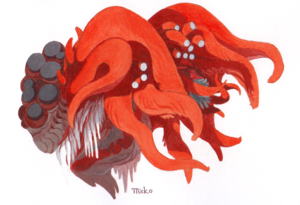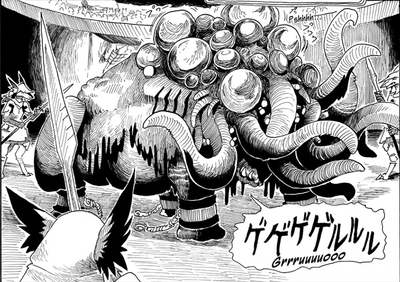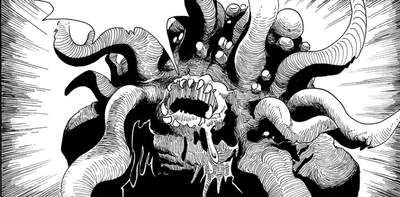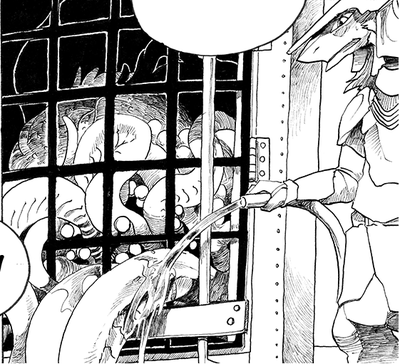Actinias
Actinias (シシブクロ) are species that belong to the Talyxian organism group. They are very large and monstrously violent. Their primary habitats include the Magoe forest, Thekan and so on.
"Actinia" is a scientific name or genus pertaining to sea anemones in the Actiniidae family of Earth Biology. Thus they are categorized as sea anemone in Talyxian biology whilst maintaining a plurality to their nature and traits which are similar to various creatures.
Biology
Actinias are one of Tal's most violent and dangerous creatures, able to charge and stampede with ease and speed across fair distances, despite their enormous size. They are incredibly durable and possess an incredible amount of stamina, capable of exerting themselves for extended periods of time before tiring out.
Their large, elephantine bodies are massive in size compared to your average Eltus. Having four, large legs similar to Earth's Odd-toed ungulates, they are capable of supporting the massive weight of their body.
They have a forward-facing head, adorned with a large amount of eyes, perfect for observing their surroundings at all times.
Their mouth is similar to that of Dondokos, albeit with slight differences. The actinia possesses significantly larger teeth, the maw is also oriented horizontally, hidden in the midst of its tentacles.
The veritable nest of tentacles adorning its frontal crown is very dexterous and prehensile, capable of extending outwards, grasping and feeling around for its surroundings or even grasp for prey.
Worthy of note is that while the muscle structure of the tentacles is similar to that of Dondoko arms and legs, capable of sensing out vibrations, they are also impressively strong. The actinia can be seen showing such strength in the Vilous comic, At the Festival, having demonstrated itself more than capable of pulling its own weight upwards with them.
Its upper back is laden with balloon-like lumps, they are able to inflate as a mechanism of self-preservation and instilling fear into other creatures by sheer virtue of making itself appear larger, when threatened.
The actinia is capable of entering a frenzy-like state, performing fast charges across short distances without losing breath, drawing upon its immeasurable stamina.
As with most Talyxians, it tends to avoid contact with salt along its sensitive mucous membranes. In the comic, the Eltus folk which captured the actinia for the Arena show had employed a new strategy to keep it docile whilst caged. Hosing it down with salt-water kept it in a somewhat dormant state almost.
Ecology
When threatened or surrounded, the actinia is capable of uttering an extremely loud and guttural roar, meant to intimidate and instill fear in the hunters or prey.
In addition, it can also inflate its somewhat spherical protuberances on the back of its neck and head via drawing in a deep breath. This display is meant to make it appear more intimidating as a result.
They have a maximum of 4 or more ink tanks (depending on size). The actinia of seen in the comic is medium size. It has inktanks on its limbs, mouth and back.
The colors and properties of the inks are different. (Varying tones between Pink and Black)
Note: If you take out the tissue without hurting it, it continues to produce ink as long as it is supplied nutrition, so it is considered a very expensive / valuable piece. Functions akin to an artificial organ as well as bears resemblance.
Actinias begin their larval days in a physical form similar to a slender octopus or spider. They hide in the ground, catching creatures which pass in front and prey upon them. Also, during this infancy period, they have a dorsal maw as well, capable of hanging onto tree roots, sucking up sap like blood. This dorsal maw closes up in time as the actinia reaches adulthood.
Actinias are omnivorous, but can be frequently found preying on other Talyxian creatures and their meat.
Relationship with Eltus people
Their meat is hard and has a rubbery texture, therefore not much can be said about it being tasty. Because of this, the value of their body parts, including the meat are considered more material than edible. So much so that using the materials harvested as food is treated as wasting their true value as materials. Moreover, some parts of them are not even edible to begin with. Some regions may produce salted meats with their edible parts, and sold in high priced, delicate flavors. In previous Shigu lands, Northern people would eat away at all the edible parts of an Actinia, but even the Northerners, mainly those part of Brave Clans, considered them more like big-game trophies rather than food eaten for pleasure.
Butchers across Tal all relish the opportunity to get their hands on an actinia carcass to harvest parts. Actinias have prized meat, skin, ink and organs that are useful to Eltus, making them highly sought after.
An Actinia's liver in particular is extremely valuable, especially if it it is able to be harvested in pristine condition, rather than damaged by the captors.
Eltus folk sometimes bid over such a creature's entrails and its various cuts of meat. They are part of what's known as the meat processing industry. This industry includes guilds and associations that work together or even rival each other in order to process the viscera, meats, assorted organs and other bits like skin, leather for sale on the markets.
It takes a large hunting party or group to take one down, as it has been shown in the comic that it is more than able to take up to over 5 spear blows. Even with some spears stuck to its hide, it continues to stampede about.
Trivia
The Talyxian actinia's Japanese name was just "sea anemone" previously, now it has been changed to Shishibukuro, which literally translates to "Lion Pot", yet it still retains the traits of sea anemones in Tal's biology.
About the origins behind the Japanese name, "Shishi" means lion in traditional Japanese words and "Bukuro" means pot, sack, bag, and so on.
The name also tangentially refers to their origins and aesthetic, due to the fact that actinia tentacles resemble a mane, and 'pot' can be interpreted as their balloon-like ink sacks, which were described in the Ecology section. For this reason, actinias are treated like lion equivalents in Japanese meanings.
They virtually possess the existence which fulfills the role of both a lion and something akin to an elephant, whilst being categorized as a sea anemone, from a biological standpoint, as well as possessing features similar to octopi.
Useful Links
Start Vilous!
Enjoy the Stories!
Peek at the World!
Terms of Service



